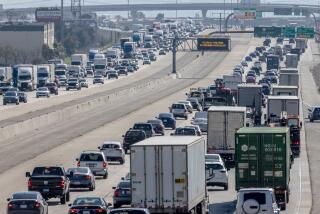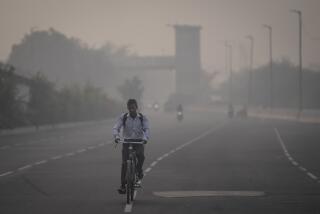Architects take Beijing’s smog into account
- Share via
Last in a series
BEIJING -- The relationship between smog and architecture is not one that critics or scholars -- or architects themselves, for that matter -- have traditionally given much thought. But in the pollution-clogged Chinese capital, the link is nearly impossible to ignore.
Often exacerbated by more benign haze and fog and by periodic dust storms, smog acts as an always-shifting veil in Beijing, shrouding old and new architecture alike. It changes the personality and color of buildings and manipulates their outlines. Huge towers just four or five blocks away fade into oblivion.
Smog levels and the Beijing skyline are thoroughly intertwined: Not only have they risen in tandem during the city’s growth spurt over the last two decades, but the construction of new skyscrapers is in part responsible for generating the haze that surrounds them when they’re finished. Architects have begun choosing color palettes and finishes for their Beijing projects with the poor visibility in mind. And in an odd twist, completed towers in Beijing now look blurrier, somehow less fully formed, than the crisp computer renderings used to promote them before they’re built.
With the Summer Olympics set to begin today, Beijing’s foul air has proved remarkably stubborn. Officials have taken half the city’s cars off the road and shut down factories across a wide swath of the country. And still the muck persists. Though the skies are marginally clearer than at this time last year, Beijing’s official pollution ratings, which some environmental watchdogs say are cooked anyway, have been hovering in unhealthy territory for much of the last two weeks.
Smog in Los Angeles, which decades ago was nearly as thick as Beijing’s is now, hangs these days mostly along the horizon. It becomes really noticeable only when you are looking at buildings in the distance, or at the L.A. basin from an airplane or hillside. Even on the soupiest of days, you can usually turn your head straight up and see a wide expanse of blue.
But in Beijing, pollution wraps the whole dome of the sky -- and the skyline -- in its fuzzy embrace. There are periods of the year when blue skies are common. But during the week I spent in the capital this summer, I caught a glimpse of the sun exactly twice. Both times it loomed as a pale disc, a single low-wattage bulb. Even a pair of big rainstorms in the middle of my stay failed to clear the air for more than a few hours.
Visibility zero
Riding through the dense Central Business District in a taxi one afternoon, I passed the China World Trade Center, a 74-story skyscraper by Skidmore, Owings & Merrill. The building looked endless, like a Jack-and-the-Beanstalk tower, because I could hardly make out its unfinished top floors. On another day, walking near Tiananmen Square, I turned toward Paul Andreu’s new National Theater -- a pair of auditoriums suspended inside a gigantic dome -- and saw only the sketchiest, silvery outlines of its curving exterior.
The effect is exaggerated by the scale of new development here. If you’re strolling on a narrow, shaded street in an older part of the city -- just as if you’re sitting in a leafy backyard in Hancock Park -- the smog is barely noticeable. But if you’re standing on a broad granite plaza at the base of a new office tower, looking from one super-block to the next, the haze swallows everything in your line of vision.
According to World Bank statistics, outdoor air pollution in China causes 350,000 to 400,000 premature deaths each year. (The World Bank also reports that 16 of the world’s 20 most polluted cities are in China.) For a lifelong Beijing resident, to look at a building whose edges are blunted by smog is, in effect, to consider your own mortality.
Color schemes
Discussion of Beijing’s smog is itself shrouded by misinformation. Government statistics on pollution levels are tough to verify. And Western journalists and bloggers who write about the subject are often flooded with complaints from online readers in China asserting that, in fact, the air in Beijing is just fine.
In general, architects say, white facades and pale stone finishes are worth avoiding in China: They look anemic against smoggy skies and show pollution’s grimy residue. Ole Scheeren, who designed the yet-unfinished CCTV headquarters with Rem Koolhaas, told me that he selected the building’s dark-glass exterior in part because of how it would appear against a flat, gray sky. “We wanted to consider the whole spectrum of forces, including pollution, that the architecture would have to withstand,” he said.
Beijing seems to lose its pizazz when the smog is thick. It’s like the Las Vegas Strip during a blackout or downtown Seattle on the 19th straight afternoon of light drizzle. It can begin to depress you and even prompt you to flee.
A case in point: As I was preparing to leave for Beijing, I e-mailed the writer James Fallows suggesting we meet for a drink. Fallows has lived in China for two years, chronicling his adventures for the Atlantic Monthly. He sent back a note begging off, with the following explanation: “Unfortunately I am going to be gone for nine days, starting this afternoon. A more-than-trivial reason is that for three weeks now I have not seen the sun here. But it is noticeably less smoggy today than for the last long stretch, so the omens may be good for your visit.”
Sadly, it didn’t turn out that way. Any improvement in air quality must have come and gone while I was watching “Semi-Pro” on the flight over.
There is a chance, of course, that the government’s wide-ranging efforts to cut down the haze will begin to pay off noticeably in the coming days. But as the China scholar Orville Schell points out, “If Chinese officials do succeed in temporarily ‘clearing the air’ in Beijing for the Olympic Games, one is left to wonder what Chinese will say if . . . severe air pollution once again is allowed to return. Will they interpret this to mean that there can only be Potemkinized clean air for foreign visitors?”
Role reversal
It sounds almost paradoxical to think of an absence of smog during the Olympics as a kind of government creation, or construct, but that’s exactly what it would be. In recent weeks the Chinese ruling party has swept beggars and protesters from the streets. It has hidden construction sites away behind colorful banners. It is now trying its best to banish unsightly, unhealthy smog in the same way.
When it comes to the effect of haze on architecture, a curious reversal is evident in Beijing and cities like it. Architectural renderings were once artfully fuzzy, with a dream-like soft focus: Think of Hugh Ferriss’ charcoal sketches of towers by Cass Gilbert or Frank Lloyd Wright’s color-pencil drawing of his Millard House in Pasadena, showing it obscured by dripping vines. It was only by visiting those buildings in person, or seeing them in photographs, that you could get a sense of the crisp, fully realized final product.
Now the opposite is often true. Renderings of proposed buildings, which are created with sophisticated software, are perfectly sharp; every detail is precise and legible. But when the structures themselves go up in Beijing and other smoggy cities, they become smudged around the edges, lifeless and two-dimensional.
Some visitors may find the idea of a veiled, enigmatic skyline, refusing to divulge too many of its aesthetic secrets, somehow romantic: Beijing as the Greta Garbo of world cities. For me, any romance wore off by my second or third day in town. I longed for a clear view of buildings I’d come halfway across the world to write about -- to see them just once set against a perfectly blue, wind-scrubbed sky.
I never got that view. By the end of my visit the city’s new towers were still clumped together in a hazy mass, each one struggling to break out of the pack and make an individual impression.
christopher.hawthorne @latimes.com
To read Christopher Hawthorne’s entire series on Architecture of the New Beijing, go to latimes.com/arts.
More to Read
The biggest entertainment stories
Get our big stories about Hollywood, film, television, music, arts, culture and more right in your inbox as soon as they publish.
You may occasionally receive promotional content from the Los Angeles Times.











